The Royal Ploughing Ceremony
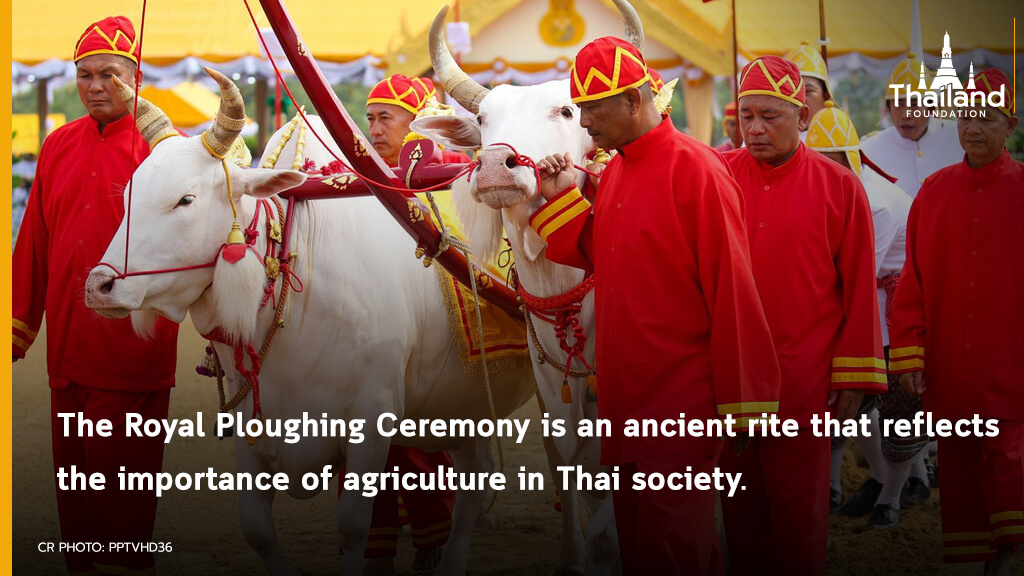
Thailand is fundamentally an agricultural society. Even though other industries, including electronics manufacturing and tourism, are now playing a role in driving the Thai economy, agriculture is still the backbone of the nation and occupies a high spiritual status among the Thais. In addition, farming is highly dependent on climate and environmental conditions. Whether the yield will be large or small is largely, if not entirely, at the mercy of nature. In an effort to build morale among farmers, Thailand observes the Royal Ploughing Ceremony every year.
In this article, we will learn about the history, activities, and values of this ceremony together.
The Purpose of The Ceremony
Other than a morale-boosting strategy, the Royal Ploughing, or the auspicious ceremony of Charot Phra Nangkhan Raek Na Khwan (จรดพระนังคัลแรกนาขวัญ) as called in Thai, serves to announce the beginning of the growing season. The ruler or head of state will preside over the ceremony to deliver this message to the people.
In Thailand, the ceremony usually takes place in May but the date is not fixed as it will be chosen by an astrologer or a Brahman priest. This year, it falls on May 13, 2022. Similar ceremonies are held in many Asian countries and named in their respective languages. For example, the event is called Preăh Réach Pĭthi Chrát Preăh Neăngkoăl in Cambodia, Lehtun Mingala in Myanmar, Vap Magula in Sri Lanka, and Ponner Uzhuthal in India.
Regarding the Thai name which is quite long, “Charot Phra Nangkhan Raek Na Khwan” (จรดพระนังคัลแรกนาขวัญ) means “to place a plough onto the earth to mark an auspicious beginning of the rice growing season.” “จรด” (charot) means to touch. “พระนังคัล” (phra nangkhan) is a plough, and “แรกนาขวัญ” (raek na khwan)” means “the first auspicious ploughing on the rice field.”
Japan also observes a ceremony comparable to the Royal Ploughing in which the Japanese emperor will plant the first rice seedling on the palace’s ground and when the harvesting season arrives, he will perform the royal harvest ceremony by being the first person to reap the produce.
History
Animistic ceremonies relating to agriculture have existed in Southeast Asia since ancient times. When the tradition of the Royal Ploughing Ceremony entered the region through the spread of Hinduism, it became intermixed with animistic practices. The ceremony was first mentioned in the Ramayana Epic written in 500-100 BCE. As the king of Videha was performing the Royal Ploughing Ceremony, a baby girl appeared from the ground. The baby will grow up to become the epic’s heroine called as Sita, which means a ploughing mark.
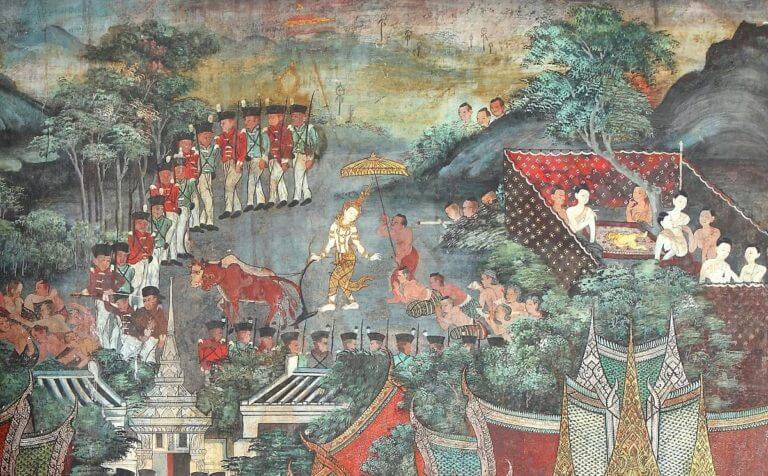
Mural depicting the ceremony [cr. silpa-mag.com]
This ceremony, influenced by Hinduism, has been practiced in Thailand since the Sukhothai Era (1238–1438), along with another Buddhist ceremony called Phuetcha Mongkhon (พืชมงคล), which literally means “auspicious plantation,” but it is also known as the Royal Harvest Festival. In this ceremony, the grains from the king will be blessed by Buddhist monks before being distributed to the people. The details of this auspicious ceremony have been changed over time as we will see below.
From the Sukhothai Era to Present
In the Sukhothai Era (1238–1438), the king did not plough the field but only presided over the ceremony. In the Ayutthaya Era (1351 – 1767), the king would enter a silent hibernation for three days and appoint a representative called “Phra Ya Raek Na” (พระยาแรกนา) to plough the field. Phra Ya Raek Na means “The Lord of the First Plough.”
In the Rattanakosin Era (1782-1932), King Rama I ordered the Minister of Agriculture to perform the duty of Phra Ya Raek Na. Another person was selected to perform the role of Phra Ya Yuen Ching Cha (พระยายืนชิงช้า) or “Lord Who Stands in the Swinging Ceremony” for the Triyampavai-Tripavai Royal Ceremony, another ceremony connected to the Royal Ploughing Ceremony. Later, King Rama III assigned only one person to perform the duties of both the swing stander and Phra Ya Raek Na. A prominent change occurred in the reign of King Rama IV when His Majesty ordered that every royal rite be accompanied by a Buddhist ceremony. To respond to this royal order, the Royal Harvest Festival was developed and has been observed along with the Brahmin-influenced Royal Ploughing Ceremony since then.
The Royal Ploughing Ceremony continued until 1936 and was interrupted for over three decades, and not until 1960 that it was revived in order to preserve the royal tradition and to enhance the morale of the Thai people. King Rama IX (1950-2016) presided over this ceremony every year during his reign, and today, King Vajiralongkorn or King Rama X, continues this royal responsibility at the royal ground called Sanam Luang in Bangkok.
The Royal Ploughing Ceremony in Thailand
- The Royal Harvest Festival or Phuetcha Mongkhon (พืชมงคล)
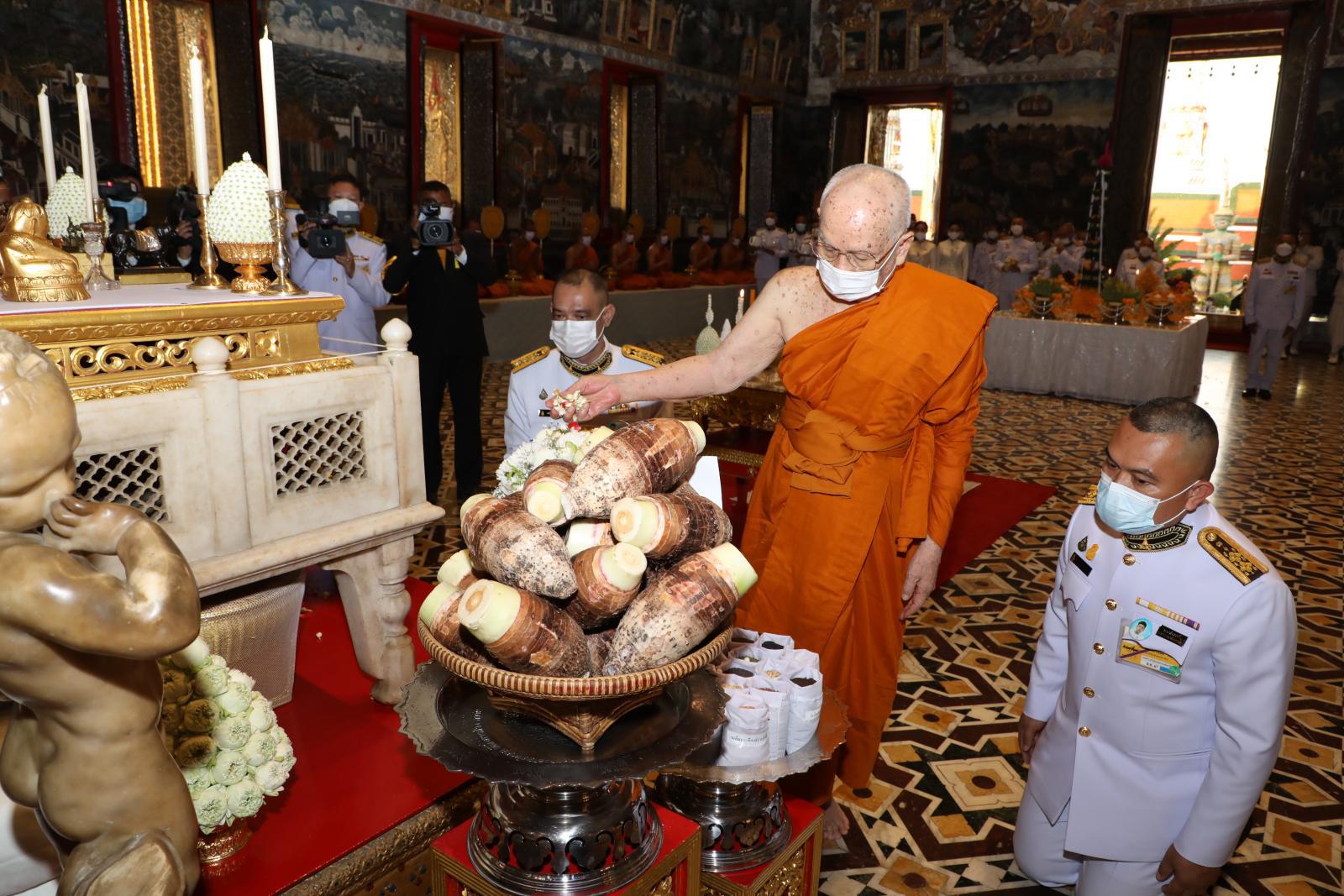
The Supreme Patriarch of Thailand blesses crops [cr. PPTV]
As already mentioned, since the reign of King Rama IV, the Royal Ploughing Ceremony and the Royal Harvest Festival have been merged. The Royal Harvest takes place first at the Grand Palace and in the following day the Royal Ploughing Ceremony is performed.
The essence of the Royal Harvest Festival is to bless the grains and seeds. Buddhist monks will bless the seeds bestowed by the palace to keep those seeds healthy and free from diseases. The seeds used in the ceremony are mainly composed of rice which is the staple grain of the Thai and 40 other types of seeds. All are packed in white cloth sachets and are ready to be cultivated. In addition, unmilled rice from the royal project grown in Chitralada Royal Villa will also be distributed to farmers and people in different provinces.
- The Royal Ploughing Ceremony
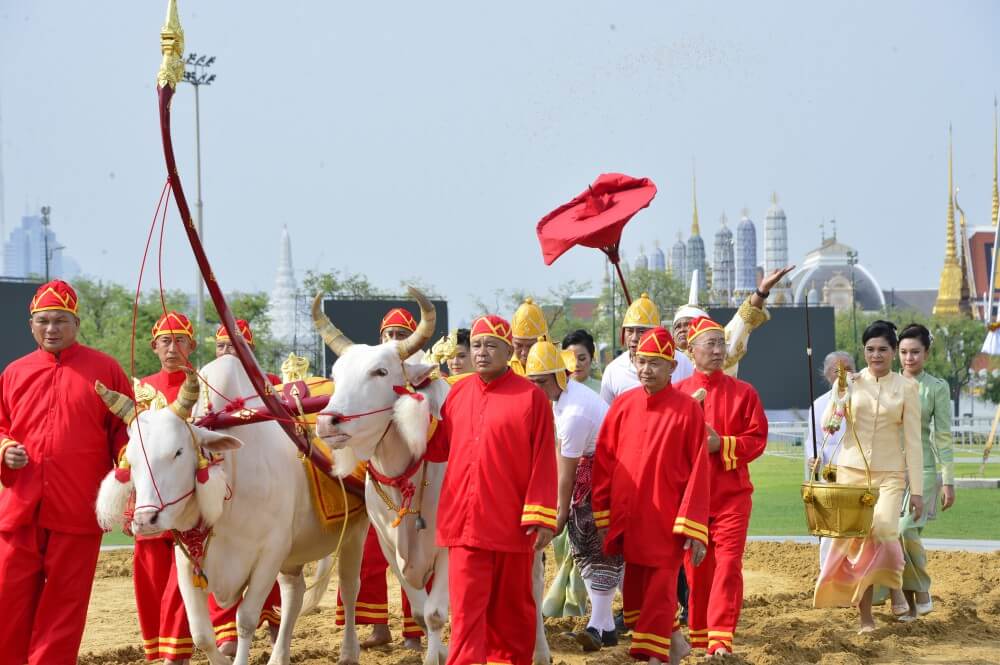
[cr. kasettumkin.com]
The Royal Ploughing Ceremony is scheduled for the day after the Royal Harvest Festival is completed. Instead of the Grand Palace, the ploughing takes place at Sanam Luang. The key event of the ceremony is to take a plough onto the ground to mark an auspicious start of the farming season. The blessed rice seeds from the day before will be sown and farmers are allowed to collect the seeds to be sown in their own plantation for good fortune. Another highlight that everyone is looking forward to is the prediction of crop fertility.
The elements involved in the prediction ceremony are as follows.
- Phra Ya Raek Na (พระยาแรกนา)
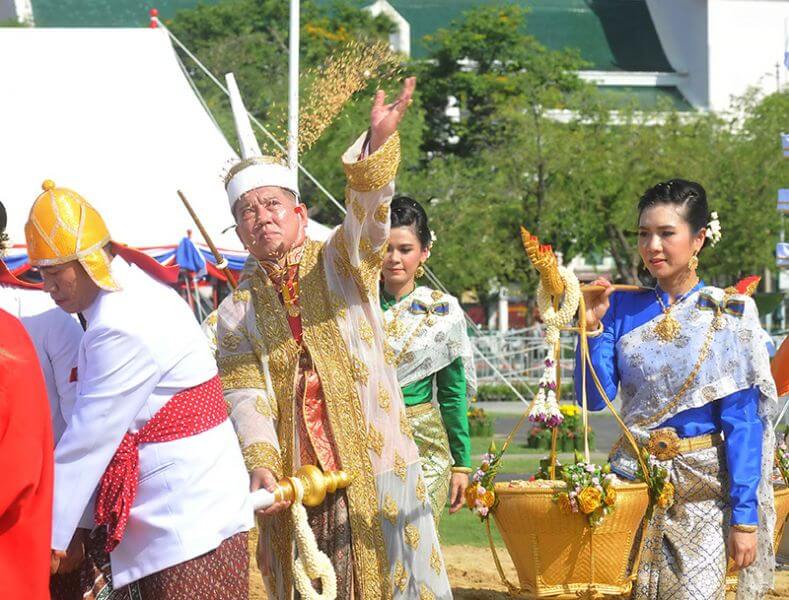
[cr. Naewna]
Today, the person who performs the duty of Phra Ya Raek Na is the Permanent Secretary of the Ministry of Agriculture and Cooperatives. The duty includes praying, choosing a piece of cloth based on which the astrologer will make a prediction, and sowing the royal rice seeds.
- The oxen
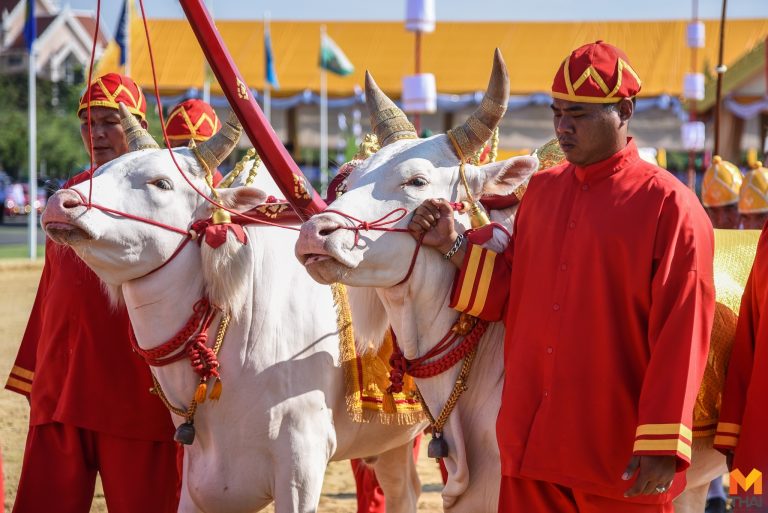
[cr. MThai]
The two oxen that are selected to participate in the ceremony must first of all be docile and healthy. They must have the same colors, beautiful skin and fur, including the lucky pattern of cowlicks. The cow horns must have the right angles and shapes. Other ideal characteristics include bright eyes, ears free from bruises and scars, beautiful and long tails, strong legs, ankles, and hooves. Their body shapes must resemble a rectangle when looked from the side.
In Hinduism, cows are regarded as deities, vehicles of Lord Shiva, and a symbol of labor and strength.
- The goddesses of the Royal Ploughing Ceremony
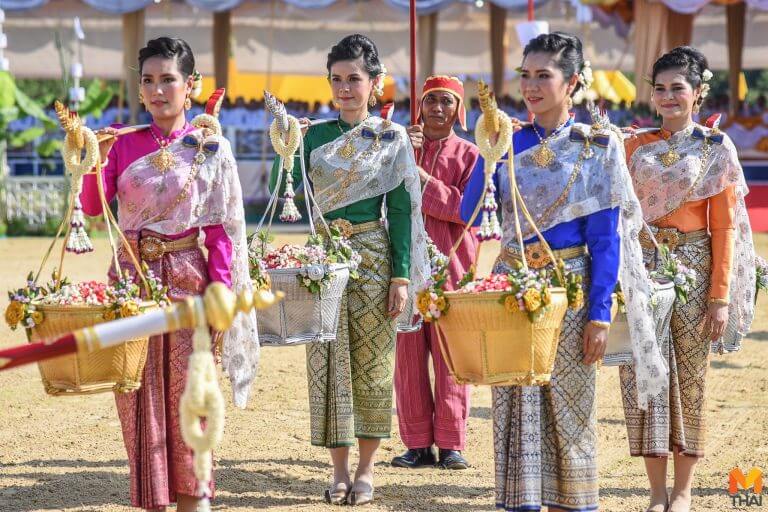
[cr. MThai]
Two couples of goddesses will be chosen from female civil servants of the Ministry of Agriculture who are still single. One couple will be carrying gold-colored baskets and the other carrying silver-colored baskets.
- The plough
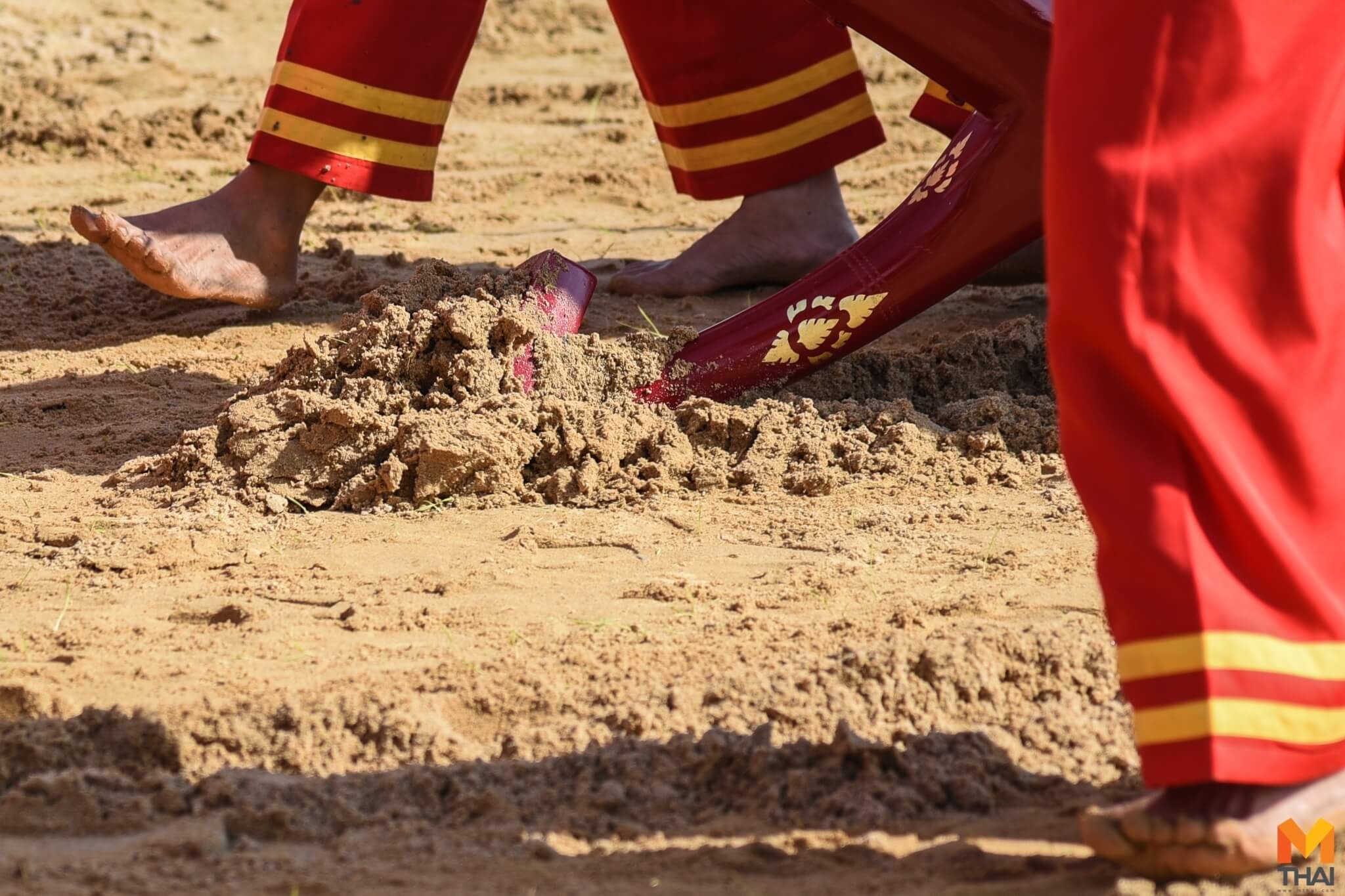
[cr. MThai]
The plough set consists of four components: a plough, a yoke, a plough base, and a three-tail flag. The plough is made of wood from a myrobalan tree, covered in lacquer and gold leaves. The head of the plow is shaped as a naga’s head. This plough set was built by a group of dairy farmers in Ratchaburi province, offered to the Royal Plowing Ceremony in 1996, and has been used in the ceremony ever since.
- The crop prediction
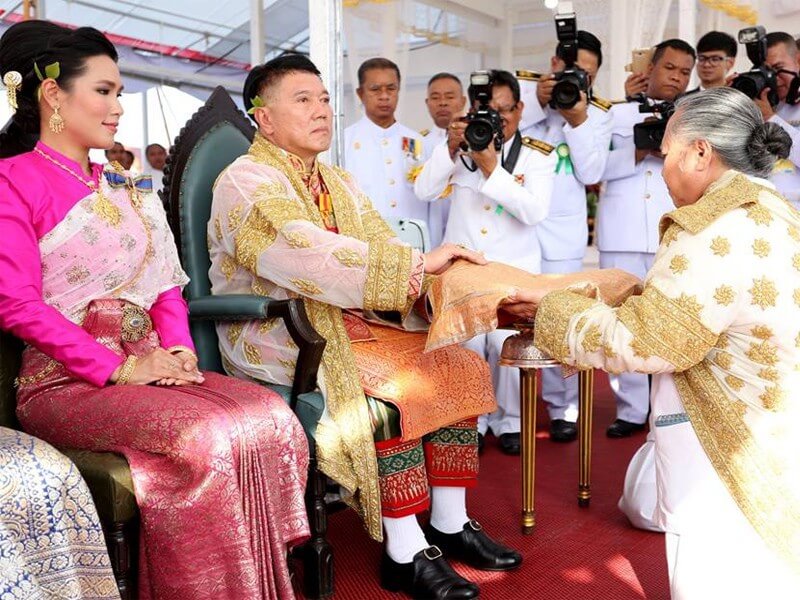
Prediction by cloth drawing [cr. kaset1009.com]
The prediction ceremony is divided into two parts. In the first part, Phra Ya Raek Na will randomly select one of the three pieces of cloth. If a one meter-long cloth is picked, it is predicted that there will be plenty of water, highland rice fields will be successful while lowland rice fields may sustain damage and will not give the best yield. If he picks a 1.25 meter-long cloth, the prediction will be entirely positive. There will be the right amount of rainfall. The rice yield will be optimal with plenty of fruit and meat. If a 1.5 meter-long cloth is chosen, the prediction will be opposite to the first prediction in that the water will not be abundant but still enough for lowland plantation while highland plantation will suffer to a certain degree.
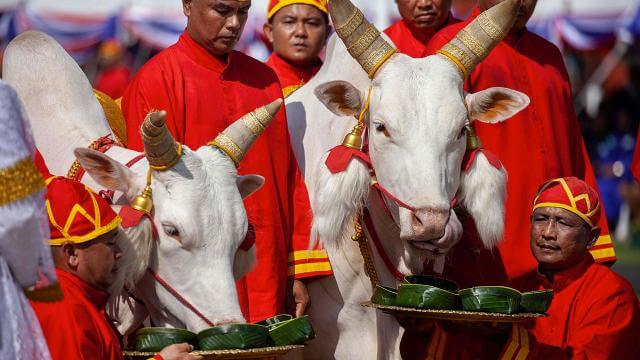
Prediction by oxen [cr. Thairath]
In the second part of the ceremony, seven kinds of food are presented to the oxen. The prediction will be drawn from the food that the oxen eat. If they eat rice or corn, it is the sign of abundant rice and fruit. If they eat nuts or sesame, then fruit and food in general will be plentiful. If water or grass is eaten, it is said that there will be enough water and people will not suffer the shortage of rice, fruit, meat, and food. Lastly, if the oxen drink alcohol, it means that overseas trade and transportation will be smooth and the economy prosperous.
- The exemplary farmers’ awards
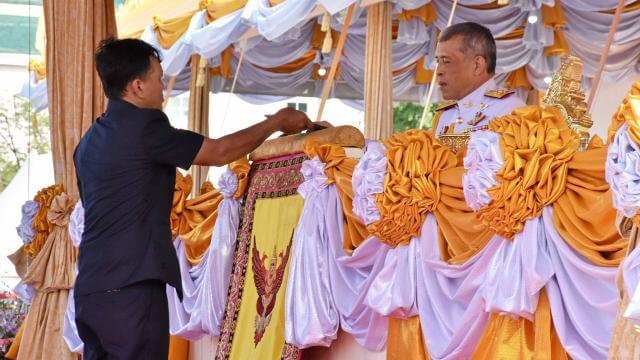
HM King Vajiralongkorn giving an award to a farmer [cr. Thairath]
Every year outstanding farmers and farmers’ organizations, including the agricultural resource persons will be selected for the exemplary farmers’ awards to honor them as role models and to publicize their work. The awards are given in 36 categories, namely 16 outstanding farmers, 13 outstanding farmers’ organizations, and 7 outstanding cooperatives. The awards ceremony also takes place at Sanam Luang.
In 1966, the Royal Ploughing Ceremony was designated as the Farmer’s Day.
Values behind the Ceremony
Agriculture is important not only for the Thai people but also for the livelihood of all human beings. Global food security depends on the economic and occupational security of farmers and agricultural countries. The fact that the agricultural ceremonies are endorsed by the king and the government, recognized as official holidays, and broadcast nationwide reflects the crucial role agriculture plays in the Thai way of life.
In Thailand, the monarch as the head of state presides over the ceremony to remind all not to forget their agricultural roots and the hard work of farmers. Farming is a difficult task. It requires patience and courage to face adversity and myriad of uncontrollable factors from natural to economical fluctuations. The presence of the king, the awards ceremony, the crop prediction, and the distribution of premium quality seeds altogether are a carefully crafted message sent to all farmers that they are cherished, respected, and not forgotten.
After all, in addition to the social and emotional functions, the Royal Ploughing Ceremony pays homage to the rice and grains that nourish the Thai people. It reminds us to conserve and protect the soil, water, forests, animals, and biodiversity that make Thailand a generous and hearty breadbasket for its own people and the world.
The story of “Royal Ploughing Ceremony” is one of the classical aspects of Thai culture and heritage. The ceremony reflects the important role of agriculture in Thai society, the connection between the monarchy and the people, as well as the reverence Thai people have toward natural forces that govern their lives. Join us in exploring more stories of Thailand and the Thai people, as we take you on a journey to discover Thainess.
Sources
- https://en.wikipedia.org/wiki/Royal_Ploughing_Ceremony
- https://www.moac.go.th/royal_ploughing-history
Author: Soonyata Mianlamai
Editor: Tayud Mongkolrat
10 May 2022
Edited 9 May 2024


